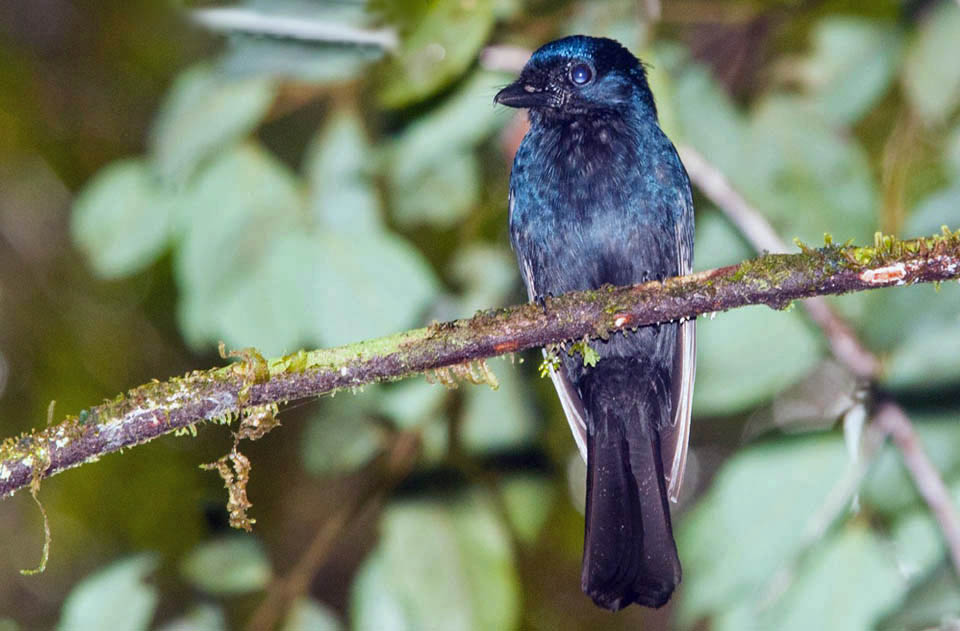
a web page by Don Roberson |
SILKTAILS Lamproliidae |
|
The family names in English [Silktails] and the scientific name [Lamproliidae] come from the endemic Silktail of Fiji. A recent a proposal to split that species into two has been widely adopted. The species on Taveuni is now Taveuni Silktail (left, in a very nice photo by Tom Tarrant). Natewa Silktail Lamprolia klinesmithi is localized to the Natewa Peninsula on Vanua Levu. The two silktails inhabit wet, mature rainforest, forest pockets, and sometimes logged forest. They feed low in the understory, including on the ground, where it flicks its tail prominently (Clunie 1984, Pratt et al. 1987). On Vanua Levu, Natewi Silktail occupies similar feeding zones to those of Fiji Shrikebill Clytorhynchus vitiensis (an endemic member of the Monarch family). This overlap results in the larger Shrikebill displacing the smaller Silktail and perhaps contributing to its rarity. On Taveuni, where it is more common, the Fiji Silktail occurs mainly in the undergrowth, thus reducing competition with Fiji Shrikebill (Heather 1977). |
The two additions to the Lamproliidae come from New Guinea and from the island of Sangihe, north of Sulawesi, Indonesia. The rather rare New Guinea bird has gone by many names. Traditionally it was called "Pygmy Drongo" or "Mountain Drongo." Irestedt et al. (2008) showed it was not a drongo but more closely related to Fantails [Rhipiduridae]. The Clements checklist coined the name Pygmy Drongo-Fantail in 2012 when moving both the Silktail and this species to the Fantails. In 2016, I stated that "in a newly-elevated family, the enigmatic Pygmy Drongo-Fantail (below, an astonishing shot by David Bishop) may become the Papuan Silktail soon!" In fact, Clements currently calls it simply Drongo Fantail [and still places this entire assemblage in the fantail family Rhipiduridae]. So it is difficult to intuit what its English name will become in the future . . . |
 |
Sometime after the turn of the 21st century a series of studies found that Chaetorhynchus was not a drongo. Instead, the DNA evidence showed that the Silktail and the Drongo-Fantail were both closely related to each other, and that together they were sister to the Fantails, family Rhipiduridae (Irestedt et al. 2008, Norman et al. 2009, Jønsson et al. 2011, Andersen et al. 2015). By about 2012, most world checklists moved them to the Fantails. In 2014, Schodde & Christidis (2014) formally proposed a subfamily name for them within the Rhipiduridae, although they noted some had advocated full Family status. Jønsson et al. (2016), using a wide range of both DNA and fossil evidence, dated their divergence from the rest of the Fantails about 22 million years ago, and proposed that this lineage was ancient enough for Family status. Pygmy Drongo-Fantail (aka Drongo Fantail, aka Papuan Silktail) is found in singles or pairs in the interior of hill or mid-mountain forests. Its song is a loud jumble of musical chips, squeaks, whistles and warbles (Coates 1990). Pratt & Beehler (2015) describe it as "a noisy bird of the forest midstory; perches on horizontal branches and sallies for insects. The foraging behavior and posture is reminiscent of Northern Fantail. It frequently joins mixed foraging flocks, stationing itself in open spaces beneath the canopy where it can pursue insects disturbed by other birds foraging above." In the first avifaunal survey of the Kumawa Mountains of western New Guinea, Diamond & Bishop (2015) found it to be a member of mixed species flocks at higher elevations in that range. |
Now, Jønsson et al. (2018) have discovered molecular evidence that Eutrichomyias rowleyi, known as Cerulean Paradise-Flycatcher (or perhaps better, Cerulean Silktail), an endemic to the island of Sangihe, is within this same lineage! It is a critically endangered species (below, in a lovely photo © James Eaton). The new field guide to the Indonesian Archipelago by Eaton et al. (2021) says that possibly as few as 50 still exist in the remnant forest on Sangihe. It occurs "singly or in pairs, joins mixed flocks; often foraging in the mid-to-upper storey near steep forested streams and gullies." Adults have head and upperparts "uniformly cerulean-blue; underparts whitish with pale blue wash" and that immature birds have "head washed grey-brown." Schodde & Christidis's (2014) diagnosis of this lineage reads, in part: "Medium-small, rather slender black songbirds with glossed or spangled plumage over the head, and patches of silky white exposed over rump and central tail feathers (Lamprolia) or hidden in base of inner wing coverts (Chaetorhynchus)." Of course the Fiji Silktail is well-known for its "silky white rump," whereas the concealed white patch at the bend of the wing in Pygmy Drongo-Fantail is rarely seen. This diagnosis statement will need revision, as this new family addition is not black or glossy. |
 |
Photos: Tom Tarrant of avecida.org photographed the Taveuni Silktail Lamprolia victoriae near Vidawa, Taveuni, Fiji, in June 2008. David Bishop photographed the Pygmy Drongo-Fantail (or Papuan Silktail) Chaetorhynchus papuensis in the Kumawa Mts., Papua, Indonesia, in March 2013. This photo was obtained during the first ever expedition to explore the high elevations of the Kumawa range. Bishop and co-workers reached this remote forests by helicopter. The Drongo-Fantail that David Bishop photographed could represent an undescribed subspecies. James Eaton photographed the Cerulean Paradise-Flycatcher (or Cerulean Silktail) Eutrichomyias rowleyi on Sangihe, Indonesia. Credited photos are © Tom Tarrant, © David Bishop, and © James Eaton, as credited, and used with permission; all rights reserved. Bibliographic note: There is no "family book" on this new family — in fact, they have rarely been placed near each other in publications. During the Handbook of the Birds of the World project, both Silktails and Cerulean Paradise-Flycatcher were covered in Monarch-Flycatchers [Monarchidae; Coates et al. 2006) while Pygmy Drongo-Fantail was covered with the Drongos{Dicruridae; Rocamora & Yeatman-Berthelot 2009]. By the time of that latter book (Vol. 14 in 2009) there was an indication in the text that Chaetorhynchus was likely aligned with Fantails. Literature cited:
|